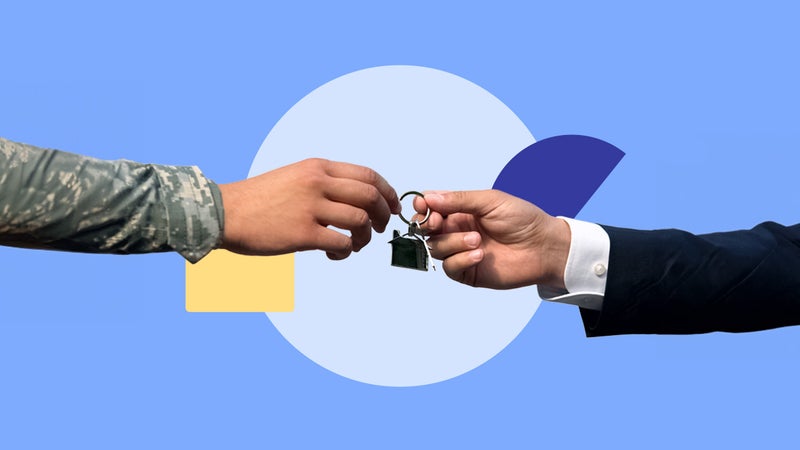VA loans: What they are and how they work

The Bankrate promise
At Bankrate we strive to help you make smarter financial decisions. While we adhere to strict , this post may contain references to products from our partners. Here's an explanation for .
Our writers and editors used an in-house natural language generation platform to assist with portions of this article, allowing them to focus on adding information that is uniquely helpful. The article was reviewed, fact-checked and edited by our editorial staff prior to publication.
Key takeaways
- VA loans are mortgages guaranteed by the U.S. Department of Veterans Affairs, available to eligible veterans, active-duty service members and surviving spouses.
- VA loans can be used to purchase or build a primary residence, refinance a current mortgage or cover renovation costs.
- VA loans offer several benefits, including no required down payment, no mortgage insurance and often competitive interest rates.
If you’re a qualifying member of the military, a VA loan can help you buy a home with no down payment. These types of mortgages have more relaxed baseline requirements than conventional loans, and sometimes better interest rates, too. Here’s a comprehensive guide.
What is a VA loan?
A VA loan is a mortgage guaranteed by the U.S. Department of Veterans Affairs (VA), specifically for eligible active-duty military, veterans and surviving spouses. If you qualify, you can use the VA loan program to buy a home, build or renovate a home or refinance to a new mortgage.
How does a VA loan work?
The VA doesn’t provide VA loans to borrowers directly. Instead, you’ll get your loan through a VA-approved mortgage lender. Many national banks offer VA loans, and there are lenders that specialize in them, too.
In most cases, borrowers don’t need to make a down payment to get a VA loan. You won’t need to pay mortgage insurance either — a key difference between VA loans and conventional and FHA loans. The latter require borrowers to pay mortgage insurance if putting down less than 20 percent.
You will need to pay the VA funding fee, however. Collectively, these fees allow the VA to guarantee VA loans, up to a certain amount. This guarantee lowers the risk lenders take on providing mortgages without a down payment. The funding fee ranges from 1.25 percent to 3.3 percent of the loan amount and applies whether you’re buying a home or refinancing (with some exceptions).
VA loan eligibility
To be eligible for a VA loan, the VA imposes service requirements. Here’s an overview:
- You’re currently on active military duty or a veteran who was honorably discharged and met the minimum service requirements.
- You served at least 90 consecutive active days during wartime or at least 181 consecutive days of active service during peacetime; or you served for more than six years in the National Guard or Selective Reserve.
- Your spouse died in the line of duty.
Before applying for a VA loan, you’ll need a certificate of eligibility, or COE, that proves you’ve satisfied the service requirements to qualify for the loan.
How to request a COE
If you have full entitlement, there’s no limit on the size of your VA loan. However, your lender will still assess what you qualify for based on your finances — including income and other debt — and might impose its own loan limit. Your entitlement will still be pegged to conforming mortgage limits, as well.
You won’t have full entitlement if you have an active VA loan you’re still paying back; you paid a previous VA loan in full and still own the home; you refinanced your VA loan into a non-VA loan and still own the home; or you experienced a short sale, deed in lieu of foreclosure or foreclosure on a previous VA loan and didn’t fully repay it. In these cases, you’re restricted to borrowing only as much as the loan limit for your county.
Lastly, you can only use a VA loan with a primary residence; investment properties and vacation homes aren’t allowed. The property also needs to meet certain safety and structural standards.
VA home loan pros and cons
For those who are eligible, VA loans have many benefits, but they also have drawbacks to consider.
Pros of a VA loan
- No down payment: VA loans allow you to purchase a home with zero down payment. In contrast, you’d need at least 3 percent down for a conventional mortgage and at least 3.5 percent down for an FHA loan.
- No mortgage insurance: Unlike conventional and FHA loans, VA loans do not require you to pay mortgage insurance, even though you aren’t making a down payment.
- Capped lender fees: The VA limits lender fees (like the loan origination fee) to 1 percent of the loan amount. This might mean lower closing costs compared to other loan types.
Cons of a VA loan
- Funding fee: VA loans charge a funding fee that varies depending on whether you’re buying a home or refinancing, you’re making a down payment (and how much) and you’ve previously used a VA loan.
- Limited to primary residences: You can only use VA loans to purchase a primary residence that you’ll live in, not rental or vacation properties. (However, you can buy up to a four-unit property with a VA loan as long as one unit is your primary residence.) In addition, not every property will meet the VA’s minimum property requirements (MPRs).
Types of VA home loans
Whether purchasing or building a home or refinancing a mortgage, there are a variety of VA loan options:
| VA purchase mortgage | For buying a home |
| VA construction loan | For building a home, including buying the land or lot, labor and materials |
| Interest Rate Reduction Refinance Loan (IRRRL) or VA streamline refinance | For refinancing to a new loan with a new interest rate and/or terms, with no appraisal or credit check required |
| VA rate-and-term refinance | For refinancing to a new loan with a new interest rate and/or terms |
| VA cash-out refinance | For refinancing to a new, larger loan with a new interest rate and/or terms, with cash out based on the home’s equity |
| VA rehab/renovation loan | For buying and fixing up a home |
| Native American Direct loan (NADL) | For Native American veterans to buy, build or fix up a home (or refinance a mortgage on a home) located on federal trust land |
Refinancing a VA loan
How to apply for a VA loan
The process of applying for a VA loan is similar to that of applying for other types of mortgages. It involves comparing offers from lenders, providing proof of employment and income and promptly responding to underwriting requests. Here are the basic steps for a VA purchase mortgage:
- Obtain your COE.
- Organize a file of information about your finances, including recent pay stubs, bank and brokerage statements and tax returns.
- Compare rate offers from at least three VA lenders.
- Request a preapproval and begin looking for homes.
- Complete the mortgage application once you have an accepted offer.
- Be ready to provide additional credit or financial information as needed during underwriting.
VA loan FAQ
-
VA loans can have term lengths of 10 to 30 years, with a fixed or adjustable rate. VA loan interest rates vary from lender to lender and by borrower, but are sometimes lower than those on conventional mortgages.
-
Entitlement is the amount of the VA loan the VA will guarantee to the lender if you default. There are two types: basic entitlement, which is up to $36,000 for loans worth less than $144,000 or 25 percent for loans of that amount or more; and bonus entitlement, which is up to 25 percent of the Federal Housing Finance Agency (FHFA) loan limit, minus the basic entitlement. If you’re getting a loan that costs more than $144,000, the bonus entitlement can be used.
-
No, VA loans don’t require PMI (private mortgage insurance) or any other mortgage insurance. However, you will have to pay a funding fee.
-
Aside from standard closing costs, VA loans come with a funding fee (with a few exceptions). If you can’t pay the fee at closing, you can it to your loan and pay it over time with your mortgage. That increases the total amount you’re borrowing and the total interest paid. Here’s what you’ll pay:
Down payment First-time use Subsequent use 0%-5% 2.15% 3.30% 5%-9.99% 1.50% 1.50% 10% or more 1.25% 1.25% -
If you’re struggling to pay your VA loan, the VA can help you find relief options with your mortgage lender or servicer. Call 877-827-3702 as soon as possible for assistance.





